Project Management Report: Analysis of Business Relocation Project
VerifiedAdded on 2019/12/03
|30
|8436
|293
Report
AI Summary
This project management report examines a business relocation project, focusing on analyzing business objectives to determine project feasibility. It includes an introduction outlining the project's scope and objectives, followed by an analysis of business needs and the identification of projects required. The report then details the subdivision of the project, estimation of time and resources, and the selection of the PRINCE2 methodology. It assesses the project's feasibility, covering financial, technological, and risk management aspects. The report also explores systems and planning for initiating, managing, and controlling the project, including the roles and responsibilities of the project manager, and the development of a detailed project plan. The organizational and management aspects, including team structures, interpersonal skills, and quality management processes, are also discussed. Furthermore, it addresses monitoring and controlling project progress by identifying risks and issues, and implementing control systems. Finally, the report covers the evaluation and closeout of the project, identifying issues in the final stages and assessing essential tasks. The report concludes with a summary of key findings and references.

PROJECT MANAGEMENT
Paraphrase This Document
Need a fresh take? Get an instant paraphrase of this document with our AI Paraphraser
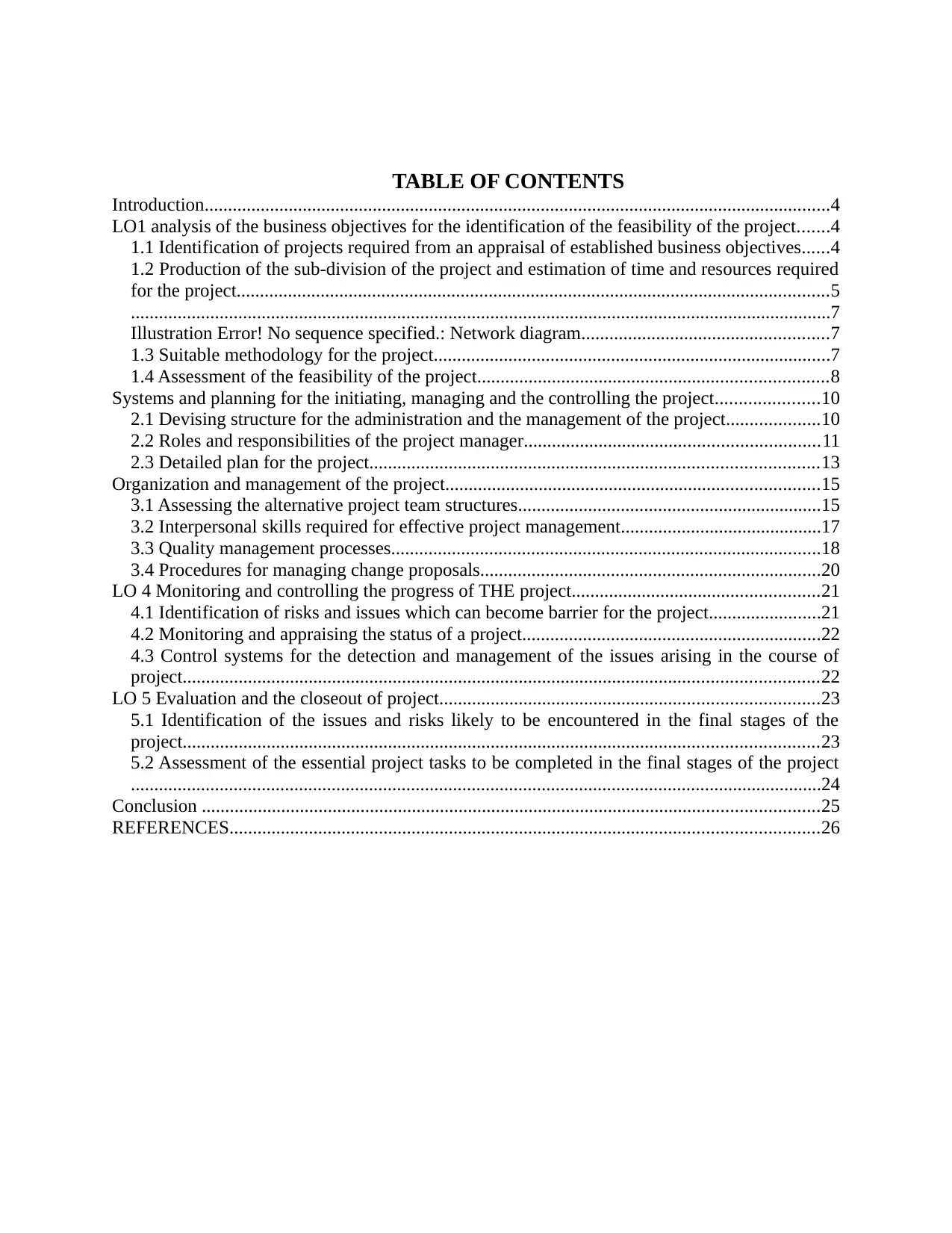
TABLE OF CONTENTS
Introduction......................................................................................................................................4
LO1 analysis of the business objectives for the identification of the feasibility of the project.......4
1.1 Identification of projects required from an appraisal of established business objectives......4
1.2 Production of the sub-division of the project and estimation of time and resources required
for the project...............................................................................................................................5
......................................................................................................................................................7
Illustration Error! No sequence specified.: Network diagram.....................................................7
1.3 Suitable methodology for the project.....................................................................................7
1.4 Assessment of the feasibility of the project...........................................................................8
Systems and planning for the initiating, managing and the controlling the project......................10
2.1 Devising structure for the administration and the management of the project....................10
2.2 Roles and responsibilities of the project manager...............................................................11
2.3 Detailed plan for the project................................................................................................13
Organization and management of the project................................................................................15
3.1 Assessing the alternative project team structures.................................................................15
3.2 Interpersonal skills required for effective project management...........................................17
3.3 Quality management processes............................................................................................18
3.4 Procedures for managing change proposals.........................................................................20
LO 4 Monitoring and controlling the progress of THE project.....................................................21
4.1 Identification of risks and issues which can become barrier for the project........................21
4.2 Monitoring and appraising the status of a project................................................................22
4.3 Control systems for the detection and management of the issues arising in the course of
project........................................................................................................................................22
LO 5 Evaluation and the closeout of project.................................................................................23
5.1 Identification of the issues and risks likely to be encountered in the final stages of the
project........................................................................................................................................23
5.2 Assessment of the essential project tasks to be completed in the final stages of the project
....................................................................................................................................................24
Conclusion ....................................................................................................................................25
REFERENCES..............................................................................................................................26
Introduction......................................................................................................................................4
LO1 analysis of the business objectives for the identification of the feasibility of the project.......4
1.1 Identification of projects required from an appraisal of established business objectives......4
1.2 Production of the sub-division of the project and estimation of time and resources required
for the project...............................................................................................................................5
......................................................................................................................................................7
Illustration Error! No sequence specified.: Network diagram.....................................................7
1.3 Suitable methodology for the project.....................................................................................7
1.4 Assessment of the feasibility of the project...........................................................................8
Systems and planning for the initiating, managing and the controlling the project......................10
2.1 Devising structure for the administration and the management of the project....................10
2.2 Roles and responsibilities of the project manager...............................................................11
2.3 Detailed plan for the project................................................................................................13
Organization and management of the project................................................................................15
3.1 Assessing the alternative project team structures.................................................................15
3.2 Interpersonal skills required for effective project management...........................................17
3.3 Quality management processes............................................................................................18
3.4 Procedures for managing change proposals.........................................................................20
LO 4 Monitoring and controlling the progress of THE project.....................................................21
4.1 Identification of risks and issues which can become barrier for the project........................21
4.2 Monitoring and appraising the status of a project................................................................22
4.3 Control systems for the detection and management of the issues arising in the course of
project........................................................................................................................................22
LO 5 Evaluation and the closeout of project.................................................................................23
5.1 Identification of the issues and risks likely to be encountered in the final stages of the
project........................................................................................................................................23
5.2 Assessment of the essential project tasks to be completed in the final stages of the project
....................................................................................................................................................24
Conclusion ....................................................................................................................................25
REFERENCES..............................................................................................................................26
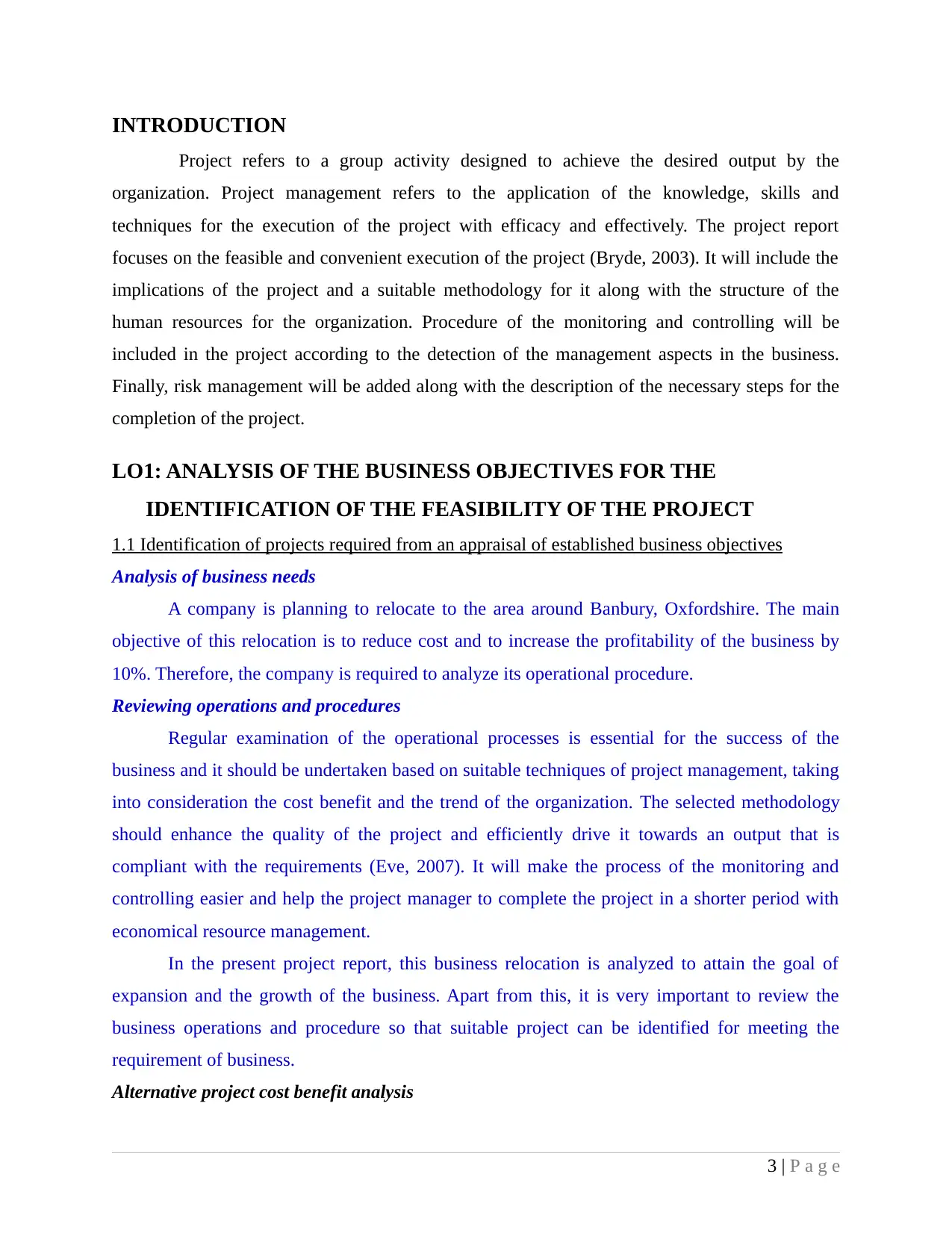
INTRODUCTION
Project refers to a group activity designed to achieve the desired output by the
organization. Project management refers to the application of the knowledge, skills and
techniques for the execution of the project with efficacy and effectively. The project report
focuses on the feasible and convenient execution of the project (Bryde, 2003). It will include the
implications of the project and a suitable methodology for it along with the structure of the
human resources for the organization. Procedure of the monitoring and controlling will be
included in the project according to the detection of the management aspects in the business.
Finally, risk management will be added along with the description of the necessary steps for the
completion of the project.
LO1: ANALYSIS OF THE BUSINESS OBJECTIVES FOR THE
IDENTIFICATION OF THE FEASIBILITY OF THE PROJECT
1.1 Identification of projects required from an appraisal of established business objectives
Analysis of business needs
A company is planning to relocate to the area around Banbury, Oxfordshire. The main
objective of this relocation is to reduce cost and to increase the profitability of the business by
10%. Therefore, the company is required to analyze its operational procedure.
Reviewing operations and procedures
Regular examination of the operational processes is essential for the success of the
business and it should be undertaken based on suitable techniques of project management, taking
into consideration the cost benefit and the trend of the organization. The selected methodology
should enhance the quality of the project and efficiently drive it towards an output that is
compliant with the requirements (Eve, 2007). It will make the process of the monitoring and
controlling easier and help the project manager to complete the project in a shorter period with
economical resource management.
In the present project report, this business relocation is analyzed to attain the goal of
expansion and the growth of the business. Apart from this, it is very important to review the
business operations and procedure so that suitable project can be identified for meeting the
requirement of business.
Alternative project cost benefit analysis
3 | P a g e
Project refers to a group activity designed to achieve the desired output by the
organization. Project management refers to the application of the knowledge, skills and
techniques for the execution of the project with efficacy and effectively. The project report
focuses on the feasible and convenient execution of the project (Bryde, 2003). It will include the
implications of the project and a suitable methodology for it along with the structure of the
human resources for the organization. Procedure of the monitoring and controlling will be
included in the project according to the detection of the management aspects in the business.
Finally, risk management will be added along with the description of the necessary steps for the
completion of the project.
LO1: ANALYSIS OF THE BUSINESS OBJECTIVES FOR THE
IDENTIFICATION OF THE FEASIBILITY OF THE PROJECT
1.1 Identification of projects required from an appraisal of established business objectives
Analysis of business needs
A company is planning to relocate to the area around Banbury, Oxfordshire. The main
objective of this relocation is to reduce cost and to increase the profitability of the business by
10%. Therefore, the company is required to analyze its operational procedure.
Reviewing operations and procedures
Regular examination of the operational processes is essential for the success of the
business and it should be undertaken based on suitable techniques of project management, taking
into consideration the cost benefit and the trend of the organization. The selected methodology
should enhance the quality of the project and efficiently drive it towards an output that is
compliant with the requirements (Eve, 2007). It will make the process of the monitoring and
controlling easier and help the project manager to complete the project in a shorter period with
economical resource management.
In the present project report, this business relocation is analyzed to attain the goal of
expansion and the growth of the business. Apart from this, it is very important to review the
business operations and procedure so that suitable project can be identified for meeting the
requirement of business.
Alternative project cost benefit analysis
3 | P a g e
⊘ This is a preview!⊘
Do you want full access?
Subscribe today to unlock all pages.

Trusted by 1+ million students worldwide
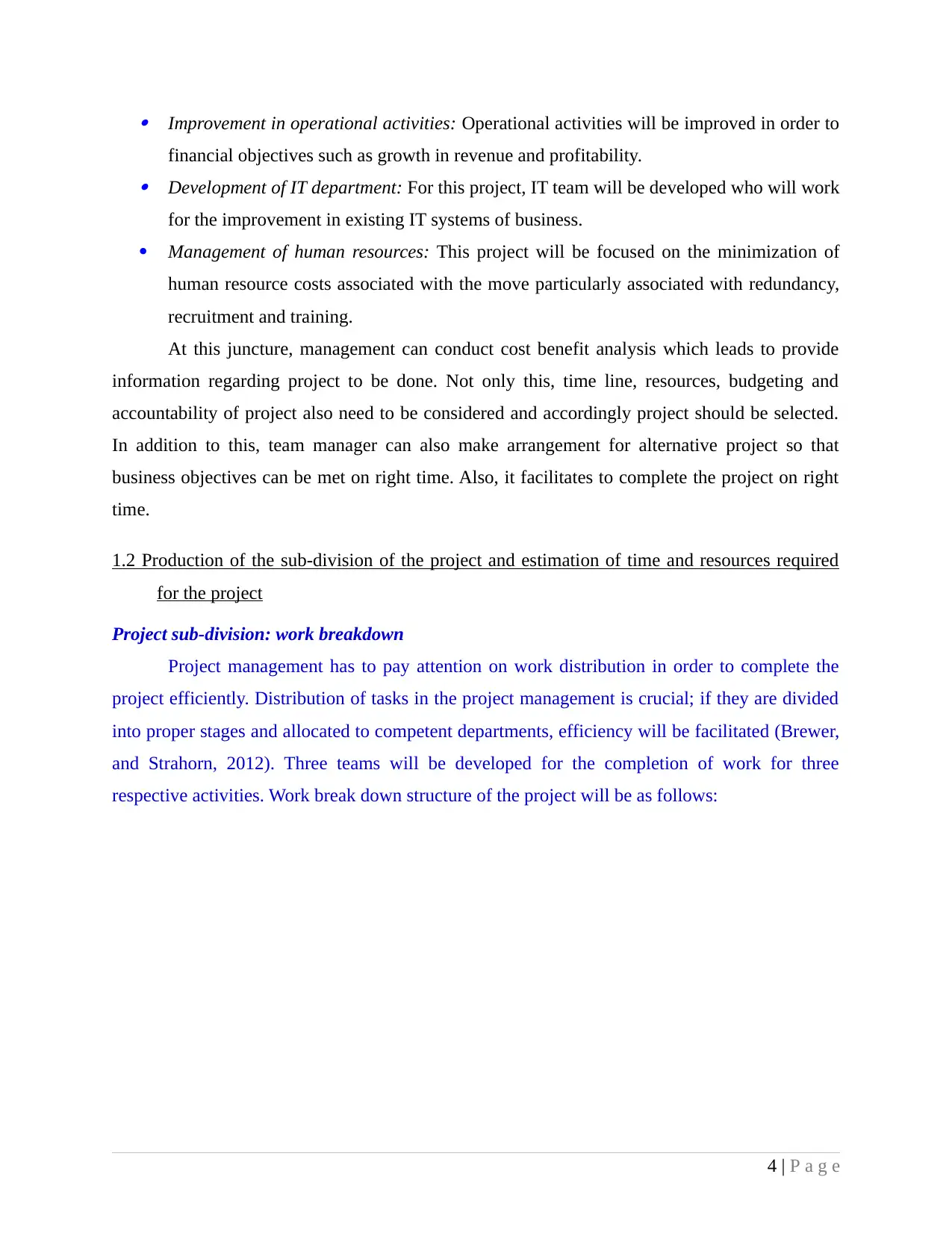
Improvement in operational activities: Operational activities will be improved in order to
financial objectives such as growth in revenue and profitability. Development of IT department: For this project, IT team will be developed who will work
for the improvement in existing IT systems of business.
Management of human resources: This project will be focused on the minimization of
human resource costs associated with the move particularly associated with redundancy,
recruitment and training.
At this juncture, management can conduct cost benefit analysis which leads to provide
information regarding project to be done. Not only this, time line, resources, budgeting and
accountability of project also need to be considered and accordingly project should be selected.
In addition to this, team manager can also make arrangement for alternative project so that
business objectives can be met on right time. Also, it facilitates to complete the project on right
time.
1.2 Production of the sub-division of the project and estimation of time and resources required
for the project
Project sub-division: work breakdown
Project management has to pay attention on work distribution in order to complete the
project efficiently. Distribution of tasks in the project management is crucial; if they are divided
into proper stages and allocated to competent departments, efficiency will be facilitated (Brewer,
and Strahorn, 2012). Three teams will be developed for the completion of work for three
respective activities. Work break down structure of the project will be as follows:
4 | P a g e
financial objectives such as growth in revenue and profitability. Development of IT department: For this project, IT team will be developed who will work
for the improvement in existing IT systems of business.
Management of human resources: This project will be focused on the minimization of
human resource costs associated with the move particularly associated with redundancy,
recruitment and training.
At this juncture, management can conduct cost benefit analysis which leads to provide
information regarding project to be done. Not only this, time line, resources, budgeting and
accountability of project also need to be considered and accordingly project should be selected.
In addition to this, team manager can also make arrangement for alternative project so that
business objectives can be met on right time. Also, it facilitates to complete the project on right
time.
1.2 Production of the sub-division of the project and estimation of time and resources required
for the project
Project sub-division: work breakdown
Project management has to pay attention on work distribution in order to complete the
project efficiently. Distribution of tasks in the project management is crucial; if they are divided
into proper stages and allocated to competent departments, efficiency will be facilitated (Brewer,
and Strahorn, 2012). Three teams will be developed for the completion of work for three
respective activities. Work break down structure of the project will be as follows:
4 | P a g e
Paraphrase This Document
Need a fresh take? Get an instant paraphrase of this document with our AI Paraphraser
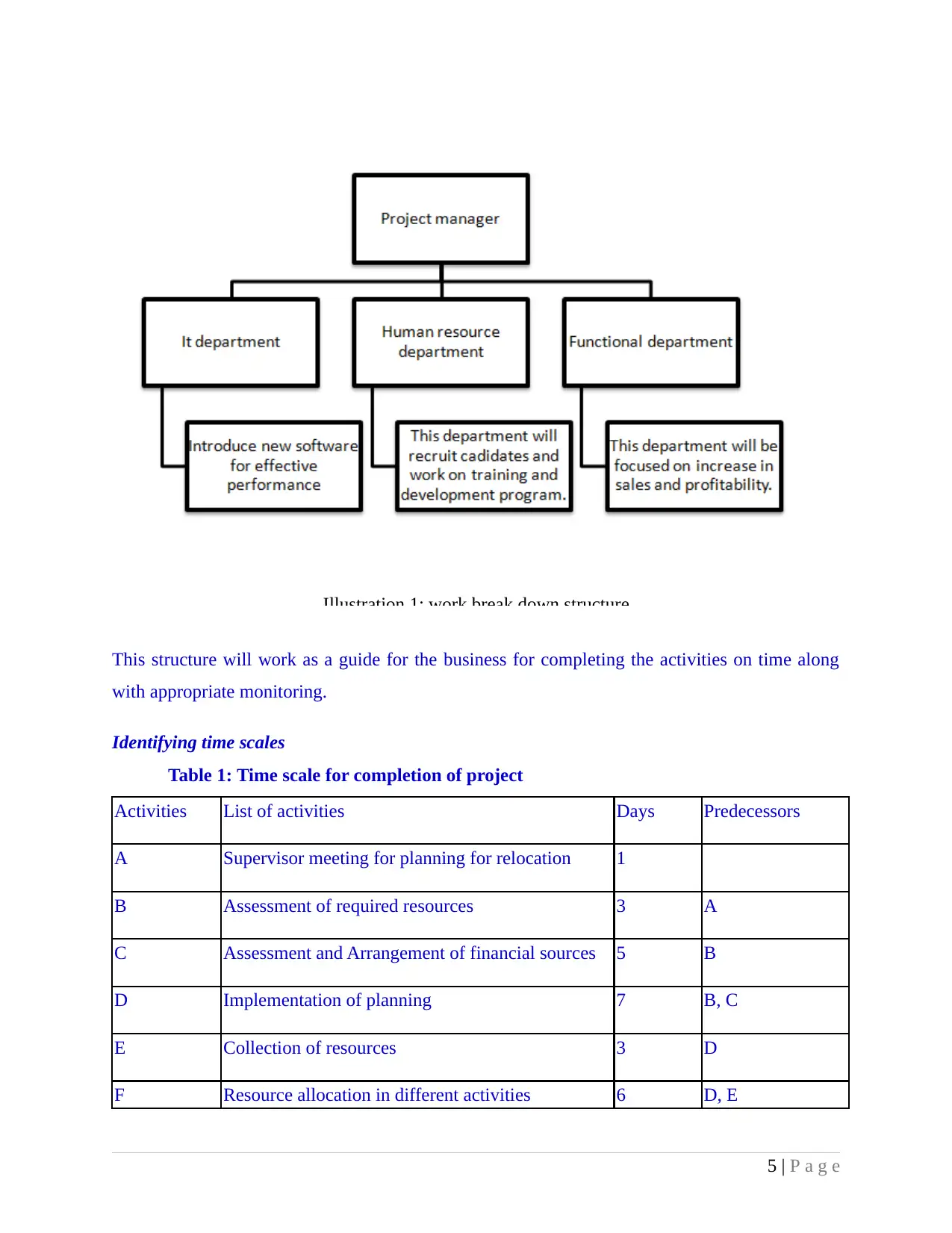
This structure will work as a guide for the business for completing the activities on time along
with appropriate monitoring.
Identifying time scales
Table 1: Time scale for completion of project
Activities List of activities Days Predecessors
A Supervisor meeting for planning for relocation 1
B Assessment of required resources 3 A
C Assessment and Arrangement of financial sources 5 B
D Implementation of planning 7 B, C
E Collection of resources 3 D
F Resource allocation in different activities 6 D, E
5 | P a g e
Illustration 1: work break down structure
with appropriate monitoring.
Identifying time scales
Table 1: Time scale for completion of project
Activities List of activities Days Predecessors
A Supervisor meeting for planning for relocation 1
B Assessment of required resources 3 A
C Assessment and Arrangement of financial sources 5 B
D Implementation of planning 7 B, C
E Collection of resources 3 D
F Resource allocation in different activities 6 D, E
5 | P a g e
Illustration 1: work break down structure
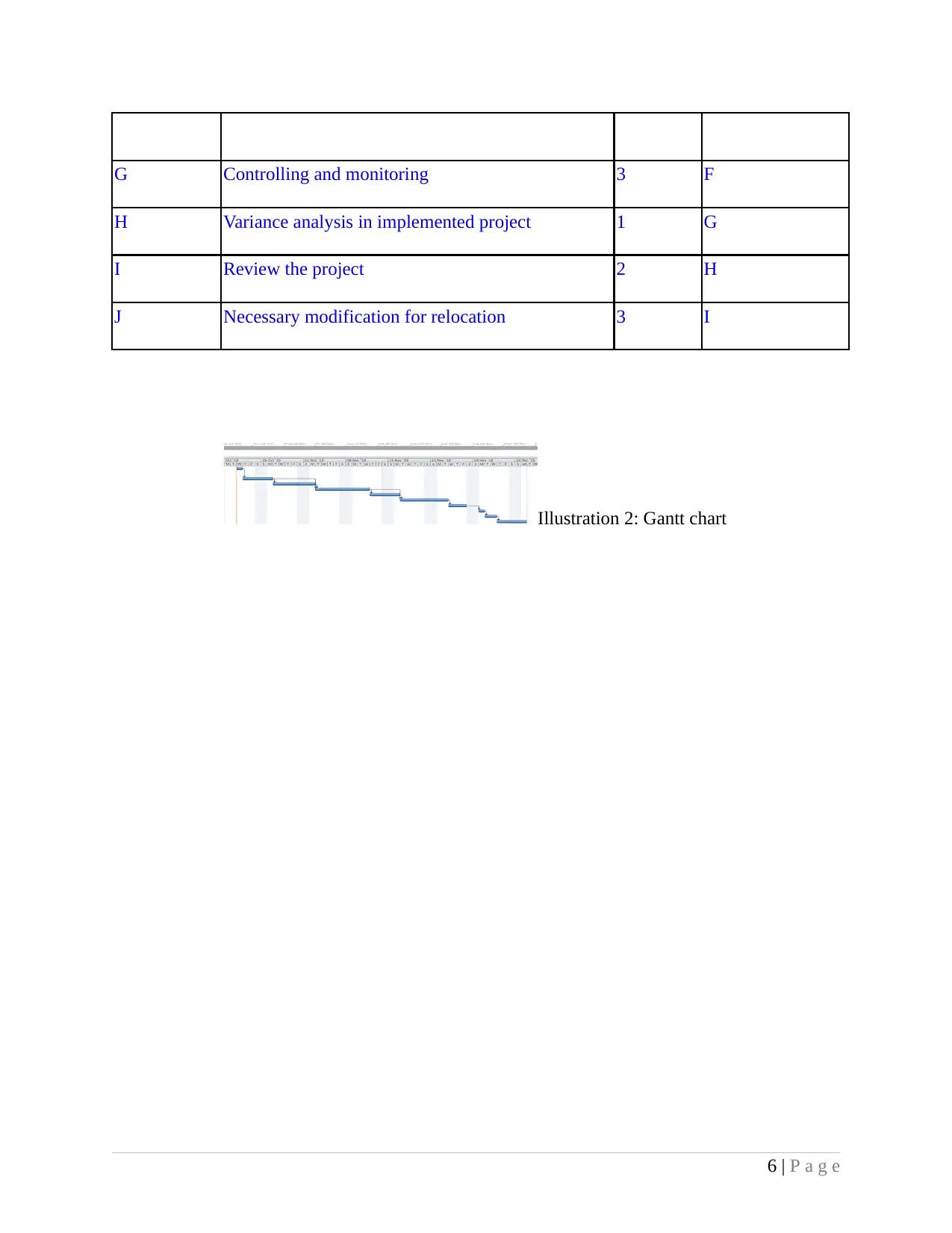
G Controlling and monitoring 3 F
H Variance analysis in implemented project 1 G
I Review the project 2 H
J Necessary modification for relocation 3 I
Illustration 2: Gantt chart
6 | P a g e
H Variance analysis in implemented project 1 G
I Review the project 2 H
J Necessary modification for relocation 3 I
Illustration 2: Gantt chart
6 | P a g e
⊘ This is a preview!⊘
Do you want full access?
Subscribe today to unlock all pages.

Trusted by 1+ million students worldwide
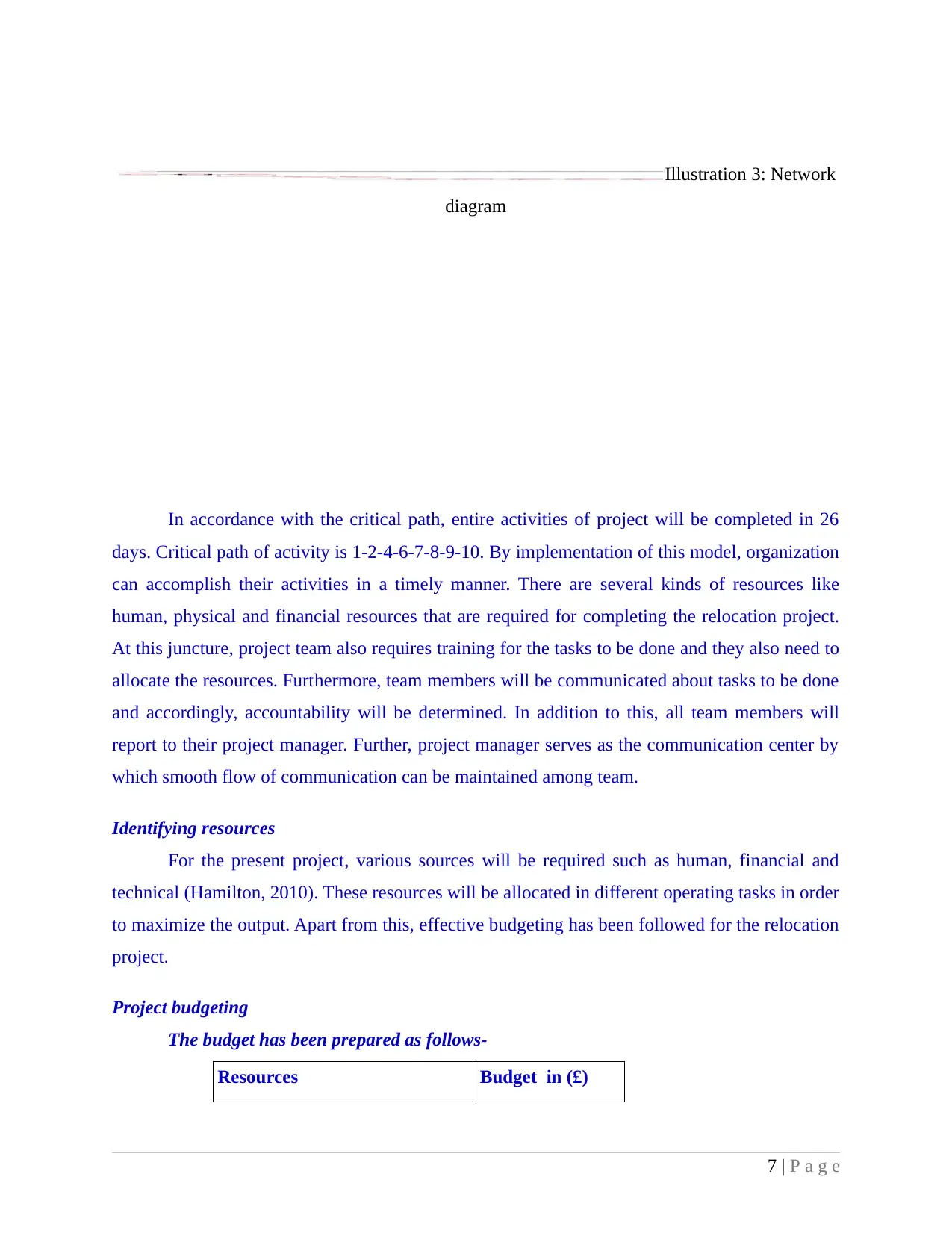
Illustration 3: Network
diagram
In accordance with the critical path, entire activities of project will be completed in 26
days. Critical path of activity is 1-2-4-6-7-8-9-10. By implementation of this model, organization
can accomplish their activities in a timely manner. There are several kinds of resources like
human, physical and financial resources that are required for completing the relocation project.
At this juncture, project team also requires training for the tasks to be done and they also need to
allocate the resources. Furthermore, team members will be communicated about tasks to be done
and accordingly, accountability will be determined. In addition to this, all team members will
report to their project manager. Further, project manager serves as the communication center by
which smooth flow of communication can be maintained among team.
Identifying resources
For the present project, various sources will be required such as human, financial and
technical (Hamilton, 2010). These resources will be allocated in different operating tasks in order
to maximize the output. Apart from this, effective budgeting has been followed for the relocation
project.
Project budgeting
The budget has been prepared as follows-
Resources Budget in (£)
7 | P a g e
diagram
In accordance with the critical path, entire activities of project will be completed in 26
days. Critical path of activity is 1-2-4-6-7-8-9-10. By implementation of this model, organization
can accomplish their activities in a timely manner. There are several kinds of resources like
human, physical and financial resources that are required for completing the relocation project.
At this juncture, project team also requires training for the tasks to be done and they also need to
allocate the resources. Furthermore, team members will be communicated about tasks to be done
and accordingly, accountability will be determined. In addition to this, all team members will
report to their project manager. Further, project manager serves as the communication center by
which smooth flow of communication can be maintained among team.
Identifying resources
For the present project, various sources will be required such as human, financial and
technical (Hamilton, 2010). These resources will be allocated in different operating tasks in order
to maximize the output. Apart from this, effective budgeting has been followed for the relocation
project.
Project budgeting
The budget has been prepared as follows-
Resources Budget in (£)
7 | P a g e
Paraphrase This Document
Need a fresh take? Get an instant paraphrase of this document with our AI Paraphraser
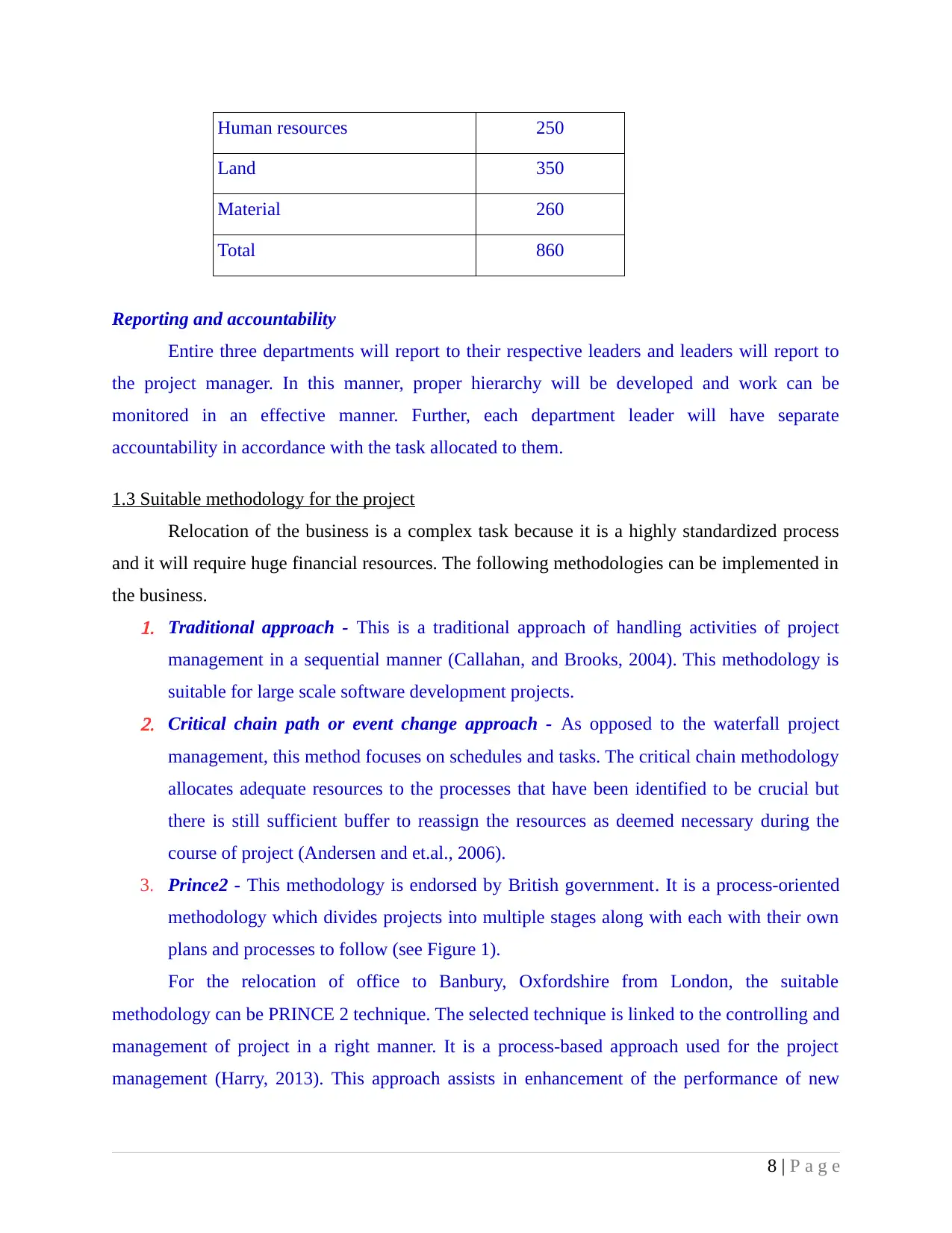
Human resources 250
Land 350
Material 260
Total 860
Reporting and accountability
Entire three departments will report to their respective leaders and leaders will report to
the project manager. In this manner, proper hierarchy will be developed and work can be
monitored in an effective manner. Further, each department leader will have separate
accountability in accordance with the task allocated to them.
1.3 Suitable methodology for the project
Relocation of the business is a complex task because it is a highly standardized process
and it will require huge financial resources. The following methodologies can be implemented in
the business.1. Traditional approach - This is a traditional approach of handling activities of project
management in a sequential manner (Callahan, and Brooks, 2004). This methodology is
suitable for large scale software development projects.2. Critical chain path or event change approach - As opposed to the waterfall project
management, this method focuses on schedules and tasks. The critical chain methodology
allocates adequate resources to the processes that have been identified to be crucial but
there is still sufficient buffer to reassign the resources as deemed necessary during the
course of project (Andersen and et.al., 2006).
3. Prince2 - This methodology is endorsed by British government. It is a process-oriented
methodology which divides projects into multiple stages along with each with their own
plans and processes to follow (see Figure 1).
For the relocation of office to Banbury, Oxfordshire from London, the suitable
methodology can be PRINCE 2 technique. The selected technique is linked to the controlling and
management of project in a right manner. It is a process-based approach used for the project
management (Harry, 2013). This approach assists in enhancement of the performance of new
8 | P a g e
Land 350
Material 260
Total 860
Reporting and accountability
Entire three departments will report to their respective leaders and leaders will report to
the project manager. In this manner, proper hierarchy will be developed and work can be
monitored in an effective manner. Further, each department leader will have separate
accountability in accordance with the task allocated to them.
1.3 Suitable methodology for the project
Relocation of the business is a complex task because it is a highly standardized process
and it will require huge financial resources. The following methodologies can be implemented in
the business.1. Traditional approach - This is a traditional approach of handling activities of project
management in a sequential manner (Callahan, and Brooks, 2004). This methodology is
suitable for large scale software development projects.2. Critical chain path or event change approach - As opposed to the waterfall project
management, this method focuses on schedules and tasks. The critical chain methodology
allocates adequate resources to the processes that have been identified to be crucial but
there is still sufficient buffer to reassign the resources as deemed necessary during the
course of project (Andersen and et.al., 2006).
3. Prince2 - This methodology is endorsed by British government. It is a process-oriented
methodology which divides projects into multiple stages along with each with their own
plans and processes to follow (see Figure 1).
For the relocation of office to Banbury, Oxfordshire from London, the suitable
methodology can be PRINCE 2 technique. The selected technique is linked to the controlling and
management of project in a right manner. It is a process-based approach used for the project
management (Harry, 2013). This approach assists in enhancement of the performance of new
8 | P a g e
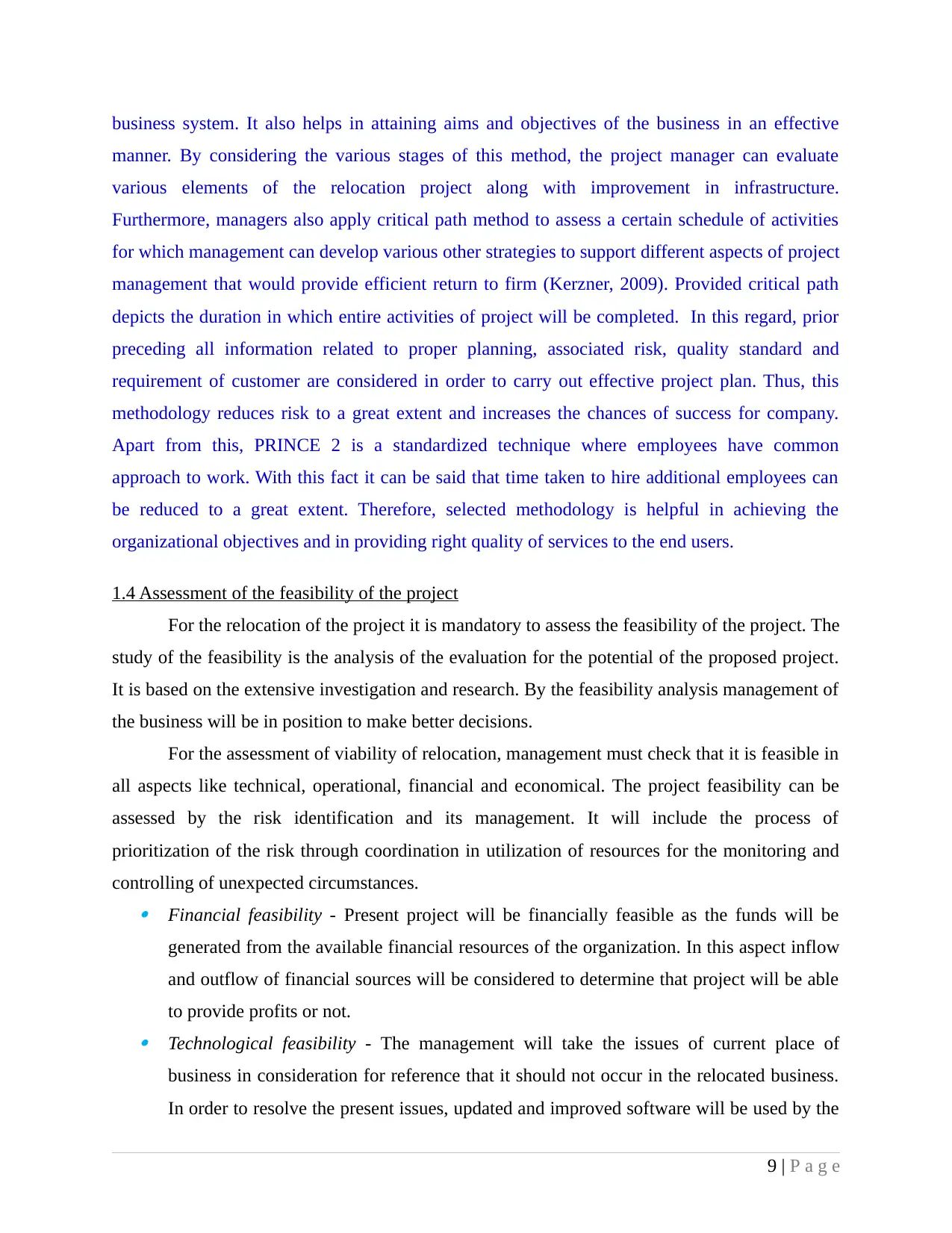
business system. It also helps in attaining aims and objectives of the business in an effective
manner. By considering the various stages of this method, the project manager can evaluate
various elements of the relocation project along with improvement in infrastructure.
Furthermore, managers also apply critical path method to assess a certain schedule of activities
for which management can develop various other strategies to support different aspects of project
management that would provide efficient return to firm (Kerzner, 2009). Provided critical path
depicts the duration in which entire activities of project will be completed. In this regard, prior
preceding all information related to proper planning, associated risk, quality standard and
requirement of customer are considered in order to carry out effective project plan. Thus, this
methodology reduces risk to a great extent and increases the chances of success for company.
Apart from this, PRINCE 2 is a standardized technique where employees have common
approach to work. With this fact it can be said that time taken to hire additional employees can
be reduced to a great extent. Therefore, selected methodology is helpful in achieving the
organizational objectives and in providing right quality of services to the end users.
1.4 Assessment of the feasibility of the project
For the relocation of the project it is mandatory to assess the feasibility of the project. The
study of the feasibility is the analysis of the evaluation for the potential of the proposed project.
It is based on the extensive investigation and research. By the feasibility analysis management of
the business will be in position to make better decisions.
For the assessment of viability of relocation, management must check that it is feasible in
all aspects like technical, operational, financial and economical. The project feasibility can be
assessed by the risk identification and its management. It will include the process of
prioritization of the risk through coordination in utilization of resources for the monitoring and
controlling of unexpected circumstances. Financial feasibility - Present project will be financially feasible as the funds will be
generated from the available financial resources of the organization. In this aspect inflow
and outflow of financial sources will be considered to determine that project will be able
to provide profits or not. Technological feasibility - The management will take the issues of current place of
business in consideration for reference that it should not occur in the relocated business.
In order to resolve the present issues, updated and improved software will be used by the
9 | P a g e
manner. By considering the various stages of this method, the project manager can evaluate
various elements of the relocation project along with improvement in infrastructure.
Furthermore, managers also apply critical path method to assess a certain schedule of activities
for which management can develop various other strategies to support different aspects of project
management that would provide efficient return to firm (Kerzner, 2009). Provided critical path
depicts the duration in which entire activities of project will be completed. In this regard, prior
preceding all information related to proper planning, associated risk, quality standard and
requirement of customer are considered in order to carry out effective project plan. Thus, this
methodology reduces risk to a great extent and increases the chances of success for company.
Apart from this, PRINCE 2 is a standardized technique where employees have common
approach to work. With this fact it can be said that time taken to hire additional employees can
be reduced to a great extent. Therefore, selected methodology is helpful in achieving the
organizational objectives and in providing right quality of services to the end users.
1.4 Assessment of the feasibility of the project
For the relocation of the project it is mandatory to assess the feasibility of the project. The
study of the feasibility is the analysis of the evaluation for the potential of the proposed project.
It is based on the extensive investigation and research. By the feasibility analysis management of
the business will be in position to make better decisions.
For the assessment of viability of relocation, management must check that it is feasible in
all aspects like technical, operational, financial and economical. The project feasibility can be
assessed by the risk identification and its management. It will include the process of
prioritization of the risk through coordination in utilization of resources for the monitoring and
controlling of unexpected circumstances. Financial feasibility - Present project will be financially feasible as the funds will be
generated from the available financial resources of the organization. In this aspect inflow
and outflow of financial sources will be considered to determine that project will be able
to provide profits or not. Technological feasibility - The management will take the issues of current place of
business in consideration for reference that it should not occur in the relocated business.
In order to resolve the present issues, updated and improved software will be used by the
9 | P a g e
⊘ This is a preview!⊘
Do you want full access?
Subscribe today to unlock all pages.

Trusted by 1+ million students worldwide
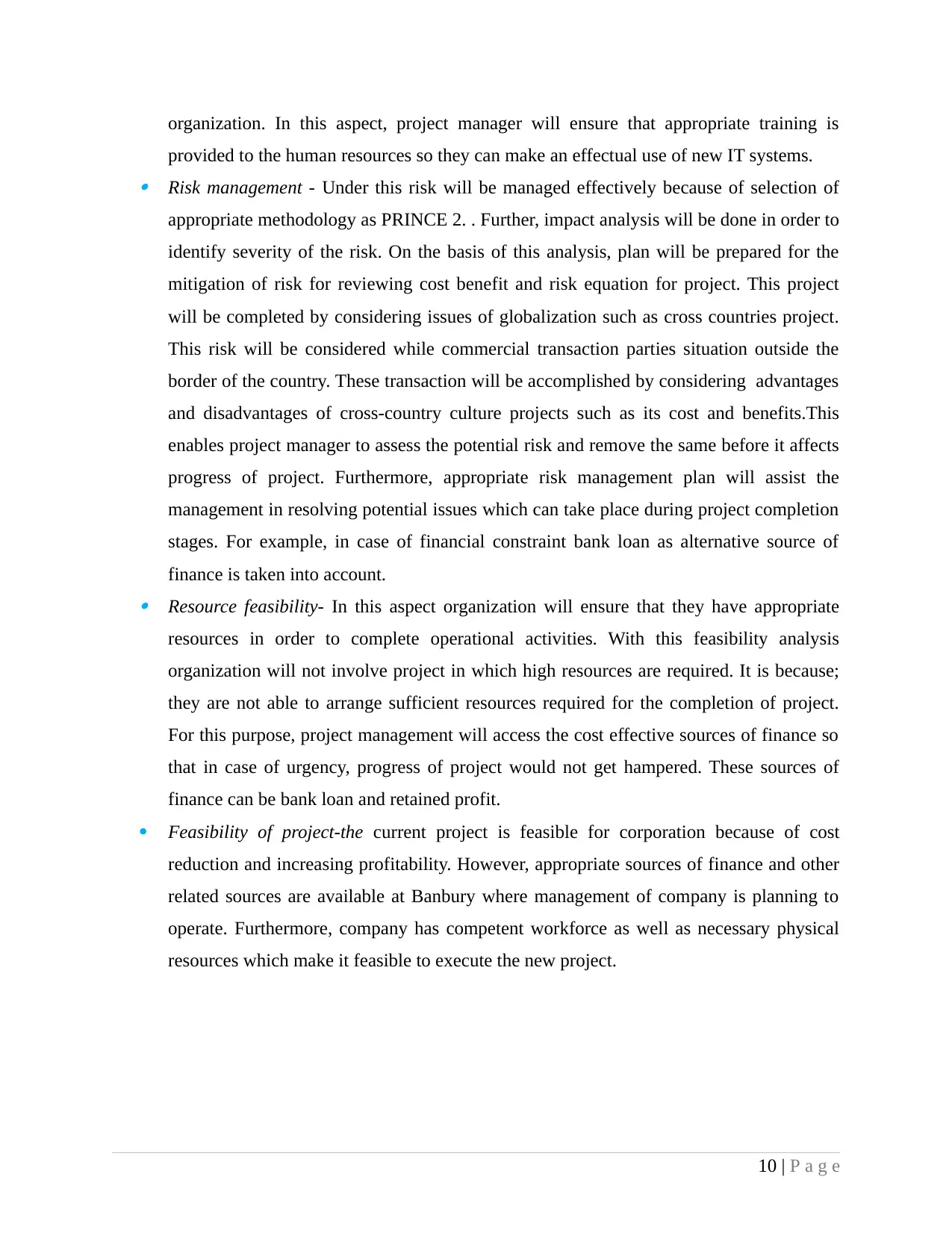
organization. In this aspect, project manager will ensure that appropriate training is
provided to the human resources so they can make an effectual use of new IT systems. Risk management - Under this risk will be managed effectively because of selection of
appropriate methodology as PRINCE 2. . Further, impact analysis will be done in order to
identify severity of the risk. On the basis of this analysis, plan will be prepared for the
mitigation of risk for reviewing cost benefit and risk equation for project. This project
will be completed by considering issues of globalization such as cross countries project.
This risk will be considered while commercial transaction parties situation outside the
border of the country. These transaction will be accomplished by considering advantages
and disadvantages of cross-country culture projects such as its cost and benefits.This
enables project manager to assess the potential risk and remove the same before it affects
progress of project. Furthermore, appropriate risk management plan will assist the
management in resolving potential issues which can take place during project completion
stages. For example, in case of financial constraint bank loan as alternative source of
finance is taken into account. Resource feasibility- In this aspect organization will ensure that they have appropriate
resources in order to complete operational activities. With this feasibility analysis
organization will not involve project in which high resources are required. It is because;
they are not able to arrange sufficient resources required for the completion of project.
For this purpose, project management will access the cost effective sources of finance so
that in case of urgency, progress of project would not get hampered. These sources of
finance can be bank loan and retained profit.
Feasibility of project-the current project is feasible for corporation because of cost
reduction and increasing profitability. However, appropriate sources of finance and other
related sources are available at Banbury where management of company is planning to
operate. Furthermore, company has competent workforce as well as necessary physical
resources which make it feasible to execute the new project.
10 | P a g e
provided to the human resources so they can make an effectual use of new IT systems. Risk management - Under this risk will be managed effectively because of selection of
appropriate methodology as PRINCE 2. . Further, impact analysis will be done in order to
identify severity of the risk. On the basis of this analysis, plan will be prepared for the
mitigation of risk for reviewing cost benefit and risk equation for project. This project
will be completed by considering issues of globalization such as cross countries project.
This risk will be considered while commercial transaction parties situation outside the
border of the country. These transaction will be accomplished by considering advantages
and disadvantages of cross-country culture projects such as its cost and benefits.This
enables project manager to assess the potential risk and remove the same before it affects
progress of project. Furthermore, appropriate risk management plan will assist the
management in resolving potential issues which can take place during project completion
stages. For example, in case of financial constraint bank loan as alternative source of
finance is taken into account. Resource feasibility- In this aspect organization will ensure that they have appropriate
resources in order to complete operational activities. With this feasibility analysis
organization will not involve project in which high resources are required. It is because;
they are not able to arrange sufficient resources required for the completion of project.
For this purpose, project management will access the cost effective sources of finance so
that in case of urgency, progress of project would not get hampered. These sources of
finance can be bank loan and retained profit.
Feasibility of project-the current project is feasible for corporation because of cost
reduction and increasing profitability. However, appropriate sources of finance and other
related sources are available at Banbury where management of company is planning to
operate. Furthermore, company has competent workforce as well as necessary physical
resources which make it feasible to execute the new project.
10 | P a g e
Paraphrase This Document
Need a fresh take? Get an instant paraphrase of this document with our AI Paraphraser
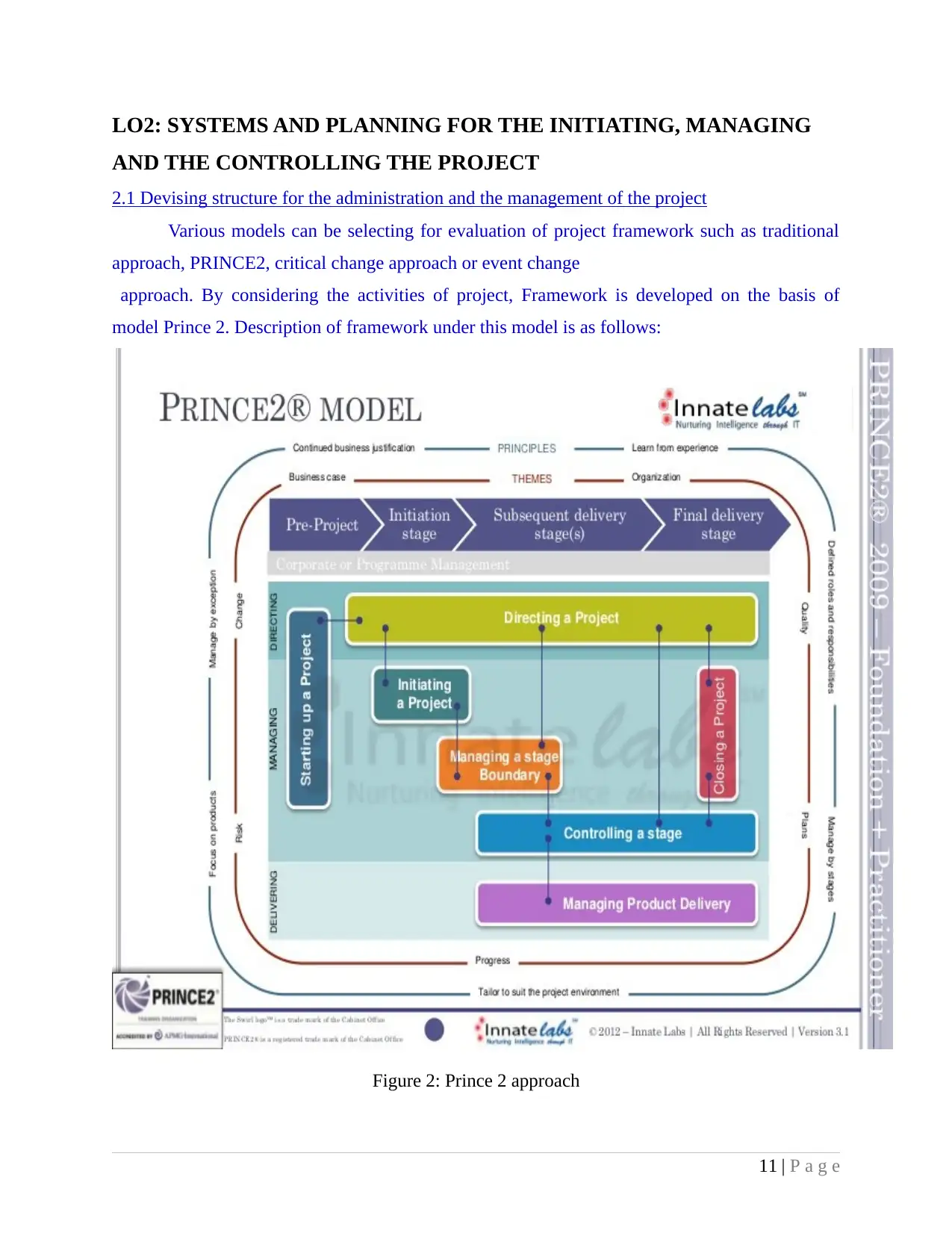
LO2: SYSTEMS AND PLANNING FOR THE INITIATING, MANAGING
AND THE CONTROLLING THE PROJECT
2.1 Devising structure for the administration and the management of the project
Various models can be selecting for evaluation of project framework such as traditional
approach, PRINCE2, critical change approach or event change
approach. By considering the activities of project, Framework is developed on the basis of
model Prince 2. Description of framework under this model is as follows:
Figure 2: Prince 2 approach
11 | P a g e
AND THE CONTROLLING THE PROJECT
2.1 Devising structure for the administration and the management of the project
Various models can be selecting for evaluation of project framework such as traditional
approach, PRINCE2, critical change approach or event change
approach. By considering the activities of project, Framework is developed on the basis of
model Prince 2. Description of framework under this model is as follows:
Figure 2: Prince 2 approach
11 | P a g e
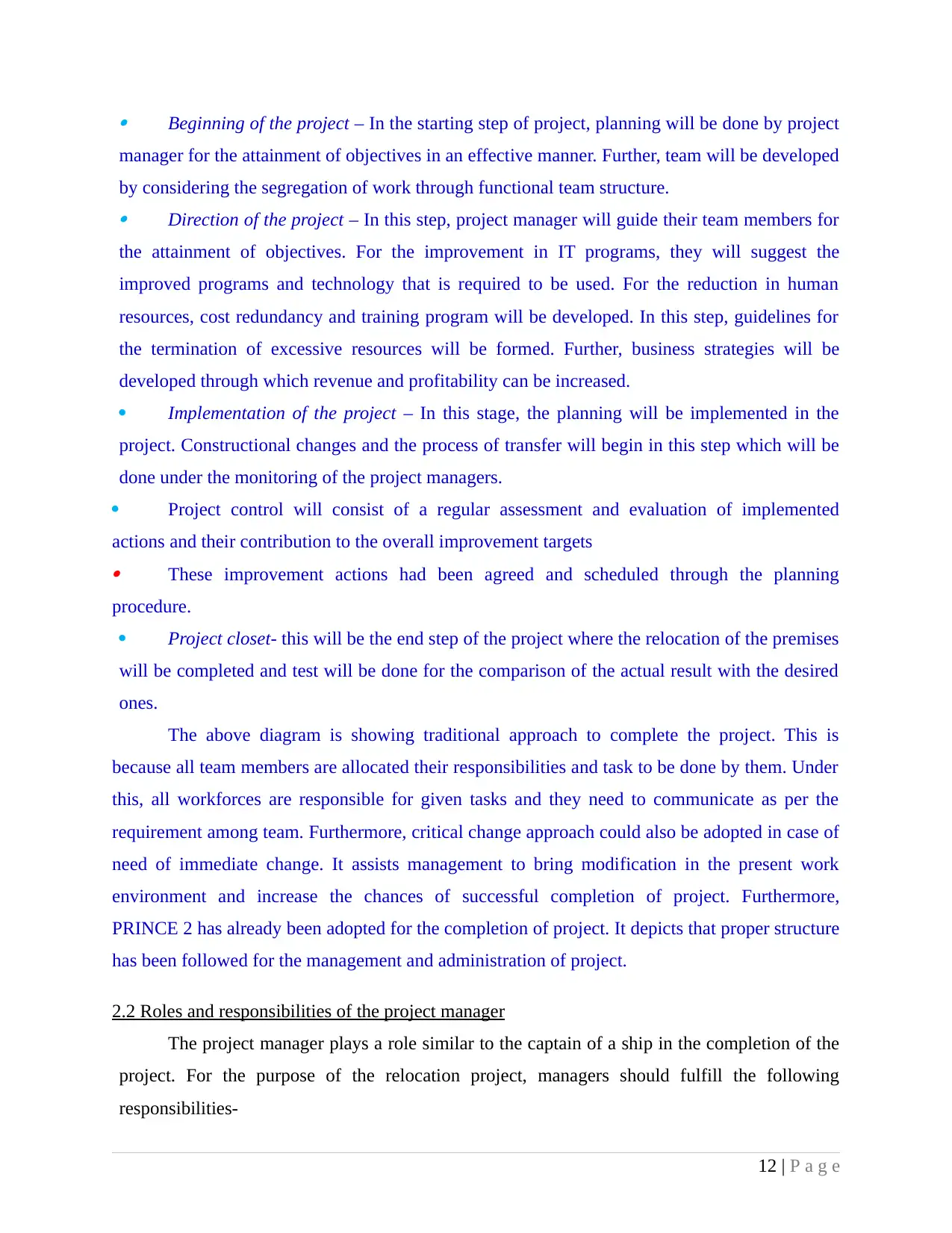
Beginning of the project – In the starting step of project, planning will be done by project
manager for the attainment of objectives in an effective manner. Further, team will be developed
by considering the segregation of work through functional team structure. Direction of the project – In this step, project manager will guide their team members for
the attainment of objectives. For the improvement in IT programs, they will suggest the
improved programs and technology that is required to be used. For the reduction in human
resources, cost redundancy and training program will be developed. In this step, guidelines for
the termination of excessive resources will be formed. Further, business strategies will be
developed through which revenue and profitability can be increased.
Implementation of the project – In this stage, the planning will be implemented in the
project. Constructional changes and the process of transfer will begin in this step which will be
done under the monitoring of the project managers.
Project control will consist of a regular assessment and evaluation of implemented
actions and their contribution to the overall improvement targets These improvement actions had been agreed and scheduled through the planning
procedure.
Project closet- this will be the end step of the project where the relocation of the premises
will be completed and test will be done for the comparison of the actual result with the desired
ones.
The above diagram is showing traditional approach to complete the project. This is
because all team members are allocated their responsibilities and task to be done by them. Under
this, all workforces are responsible for given tasks and they need to communicate as per the
requirement among team. Furthermore, critical change approach could also be adopted in case of
need of immediate change. It assists management to bring modification in the present work
environment and increase the chances of successful completion of project. Furthermore,
PRINCE 2 has already been adopted for the completion of project. It depicts that proper structure
has been followed for the management and administration of project.
2.2 Roles and responsibilities of the project manager
The project manager plays a role similar to the captain of a ship in the completion of the
project. For the purpose of the relocation project, managers should fulfill the following
responsibilities-
12 | P a g e
manager for the attainment of objectives in an effective manner. Further, team will be developed
by considering the segregation of work through functional team structure. Direction of the project – In this step, project manager will guide their team members for
the attainment of objectives. For the improvement in IT programs, they will suggest the
improved programs and technology that is required to be used. For the reduction in human
resources, cost redundancy and training program will be developed. In this step, guidelines for
the termination of excessive resources will be formed. Further, business strategies will be
developed through which revenue and profitability can be increased.
Implementation of the project – In this stage, the planning will be implemented in the
project. Constructional changes and the process of transfer will begin in this step which will be
done under the monitoring of the project managers.
Project control will consist of a regular assessment and evaluation of implemented
actions and their contribution to the overall improvement targets These improvement actions had been agreed and scheduled through the planning
procedure.
Project closet- this will be the end step of the project where the relocation of the premises
will be completed and test will be done for the comparison of the actual result with the desired
ones.
The above diagram is showing traditional approach to complete the project. This is
because all team members are allocated their responsibilities and task to be done by them. Under
this, all workforces are responsible for given tasks and they need to communicate as per the
requirement among team. Furthermore, critical change approach could also be adopted in case of
need of immediate change. It assists management to bring modification in the present work
environment and increase the chances of successful completion of project. Furthermore,
PRINCE 2 has already been adopted for the completion of project. It depicts that proper structure
has been followed for the management and administration of project.
2.2 Roles and responsibilities of the project manager
The project manager plays a role similar to the captain of a ship in the completion of the
project. For the purpose of the relocation project, managers should fulfill the following
responsibilities-
12 | P a g e
⊘ This is a preview!⊘
Do you want full access?
Subscribe today to unlock all pages.

Trusted by 1+ million students worldwide
1 out of 30
Related Documents
Your All-in-One AI-Powered Toolkit for Academic Success.
+13062052269
info@desklib.com
Available 24*7 on WhatsApp / Email
![[object Object]](/_next/static/media/star-bottom.7253800d.svg)
Unlock your academic potential
Copyright © 2020–2025 A2Z Services. All Rights Reserved. Developed and managed by ZUCOL.





